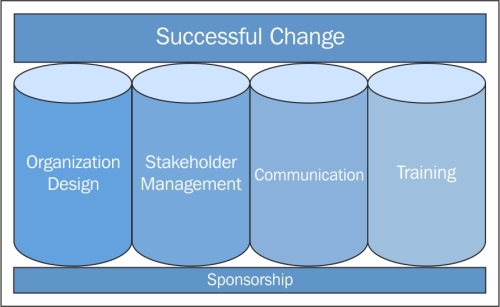The Pillars of Change
There are five major components of every Change Management program. They are referred to as the Pillars of Change because they support the adoption of the change. More importantly, they support people throughout the implementation of the change. Every pillar is designed to make it easier for people within the organization to adopt the change, shown as follows:

The Pillars of Change support the successful implementation of change
Although the preceding figure makes it look as though each pillar is independent, they are actually all integrated. The activities you conduct in one pillar impact the activities you need to conduct in all of the other pillars. You'll also notice that the pillars are round. This is because, as we will discuss in later chapters, Change Management activities form a loop of evaluation and continuous improvement. No matter how good you become at creating Change Management plans, you will always need to gather feedback throughout the project and use it to update and improve your scheduled activities.
If you were to view the Pillars of Change from a bird's-eye view, they would look a bit like the following:

The Pillars of Change are integrated and cyclical
Let's take a minute now to briefly define each pillar:
Sponsorship: Sponsorship serves as the foundation of all Change Management activities. It means supporting leaders throughout the organization for the change. Leaders can be members of the organization's leadership team, such as the CEO and department heads, or they can be unofficial leaders. Unofficial leaders are people who have influence among their peer groups and can lead others to adopt the change. We will discuss how to build sponsorship for the change in detail in Chapter 3, Building Sponsorship for the Change.
Organization design: Organization design focuses on how the structure of your organization needs to adapt to support the change you are implementing. It can involve changes to department structures, job activities, or the number of employees who perform a certain task. It can also involve the creation or removal of roles or groups. This is a task that should always be performed in conjunction with Human Resources and business representatives. Many organizations either skip this step entirely or wait to focus on it until after the change is implemented. In the next chapter, we will discuss some important aspects of organization design that should be considered as part of a successful Change Management program.
Stakeholder management: Stakeholder management involves understanding who is impacted by the change and the specific ways, both positive and negative, in which these people are impacted. This understanding will drive your communication and training activities. In Chapter 4, Managing Your Stakeholders, you will complete a number of activities to help you prepare to manage your stakeholders.
Communication: Communication is the process of sending the right message to the right people at the right time using the right channel. It also requires you to receive and understand messages from your stakeholders, and use them to influence your Change Management program. We will do some in-depth work on communicating change in Chapter 5, Communicating the Change.
Training: Training here is the process of enabling your stakeholders to successfully act on the change. Whether this involves correctly following a process, using a new computer system, or behaving in a new way, training is crucial to the success of the change. Because training is a large, complex topic, Chapter 6, Using Training to Prepare Your Stakeholders, will help you create your training strategy. Please note, it will not provide step-by-step details on how to develop and deliver training.

































































